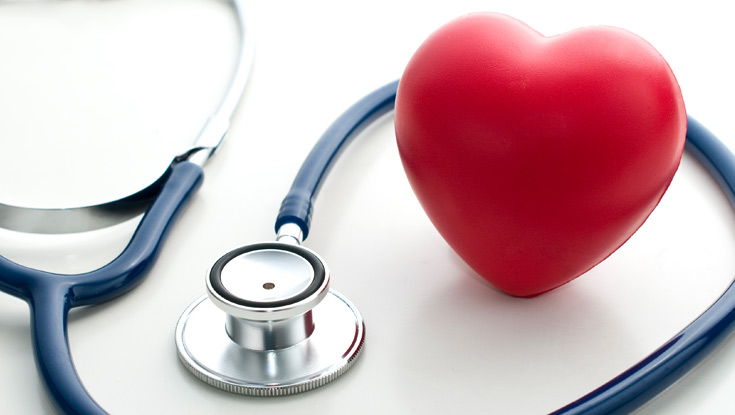5 Ways to Lower Your Blood Pressure

February is American Heart Month, a time when all people can focus on their cardiovascular health. The CDC’s Division for Heart Disease and Stroke Prevention is shining a light this year on high blood pressure, a leading risk factor for heart disease and stroke – the first and fifth leading causes of death in the United States, respectively.
What is high blood pressure?
Blood pressure is the pressure of blood pushing against the walls of your arteries. Arteries carry blood from your heart to other parts of your body. Your blood pressure normally rises and falls through the day.
Blood pressure is measured using two numbers. The first, called systolic blood pressure, measures the pressure in your arteries when your heart beats. The second number, called diastolic blood pressure, measures the pressure in your arteries when your heart rests between beats. For example, if the measurement reads 120 systolic and 80 diastolic, you would say, “120 over 80” or write, “120/80Hg.”
The American College of Cardiology and the American Heart Association consider high blood pressure to be 130 systolic or higher and 80 diastolic or higher. Your blood pressure is considered “elevated” if it is in the range of 120-129 systolic and less than 80 diastolic.
High blood pressure (also known as hypertension), can damage your arteries by making them less elastic, which decreases the flow of blood and oxygen to your heart and leads to heart disease. In addition, the Centers for Disease Control and Prevent (CDC) notes that decreased blood flow to the heart can cause:
- Chest pain, also called angina.
- Heart attack, which happens when the blood supply to your heart is blocked and heart muscle begins to die without enough oxygen. The longer the blood flow is blocked, the greater the damage to the heart.
Heart failure, a condition that means your heart can’t pump enough blood and oxygen to your other organs.
Why is high blood pressure a ‘silent killer’?
“We call hypertension the ‘silent killer’ because many people may have no symptoms and believe that they are healthy, when they are really at an increased risk for heart disease, heart failure and other related illnesses. And you may not have any symptoms until serious damage has been done to your internal organs including not only your heart but your brain, kidneys and eyes,” said Gina Zichittella, a certified nurse practitioner at Baystate Cardiology in Palmer.
“That’s why early detection is so important, so that you and your primary care physician can develop a plan to bring your blood pressure down. And that’s also why it is important to visit your doctor regularly and to not miss any scheduled appointments,” she added.
How common is high blood pressure?
Approximately 1 in 3 American adults (that’s more than 100 million people), has high blood pressure. Only about 1 in 4 has their high blood pressure under control.
High blood pressure is more likely as you age. According to the American Heart Association, you’re more likely to develop high blood pressure in your late 30s or early 40s. Nearly half of all adults with high blood pressure are women, and at age 65 and older women are more likely than men to get high blood pressure.
High blood pressure is so common in African-Americans in the U.S. that it ranks among the highest in the world – more than 40% of non-Hispanic African-American men and women have high blood pressure. For African-Americans, high blood pressure also develops earlier in life and is usually more severe.
“We have been seeing for quite a while now more younger adults and children developing high blood pressure as a result of our unhealthy lifestyles resulting in a rise in obesity,” said Zichittella.
One interesting note – blood pressure varies by geography and Massachusetts is among some 10 states to have the lowest prevalence of hypertension. You can visit this interactive map (a collaboration between the CDC and the Robert Wood Johnson Foundation) to learn more about health statistics in your local area.
How to Lower Your Blood Pressure
Many people with high blood pressure can lower their blood pressure into a healthy range or keep their numbers in a healthy range by making lifestyle changes. Zichittella and the CDC recommend talking to your healthcare team about the following lifestyle changes to help control your blood pressure:
1. Exercise regularly
Get at least 150 minutes of physical activity each week (about 30 minutes a day, 5 days a week). Exercise can help you maintain a healthy weight and lower your cholesterol and blood pressure.
2. Quit smoking
According to the American Heart Association and the U.S. surgeon general, your body starts to recover right away when you quit smoking. Within the first 20 minutes, your blood pressure and heart rate recover from nicotine-induced spikes. Over time, your carbon monoxide levels normalize, your circulation and lung function begins to improve, and your risk for cancer and coronary heart disease decreases.
3. Eat a healthy diet, including limiting sodium (salt) and alcohol
A high sodium diet can raise blood pressure and contribute to heart disease. Following the DASH Diet (Dietary Approaches to Stop Hypertension – recommended by the American Heart Association and the National Institutes of Health) can lower blood pressure in just 14 days.
4. Keep a healthy weight
Blood pressure increases as weight increases. Doctors often look at body mass index (BMI) to figure out if you are at a healthy weight. Try the CDC BMI calculator and talk to your doctor to learn more.
5. Manage your stress
Stress is known to contribute to poor diet and other unhealthy habits. The link between stress and hypertension is still being studied, but we do know that stress affects our bodies and our wellbeing. When we’re stressed, our bodies respond by releasing stress hormones into our blood. These hormones make our heart beat faster, which raises our blood pressure temporarily. If you have chronic stress, your body is often in “high gear” putting you in a repeated “fight or flight” response. Learn more about stress and heart disease risk.
Work with Your Doctor
Sometimes lifestyle changes are not enough. Many people need to take medicine in addition to making lifestyle changes.
“Remember that monitoring your blood pressure with the support of your healthcare team can help lower your risk for heart disease and stroke. You can check your blood pressure at your doctor’s office, at a pharmacy, or even at home,” said Zichittella.

Do you know your risk?

Stay on Track

2023 Heart Health Series

Health & Wellness Tips
Back to Top

